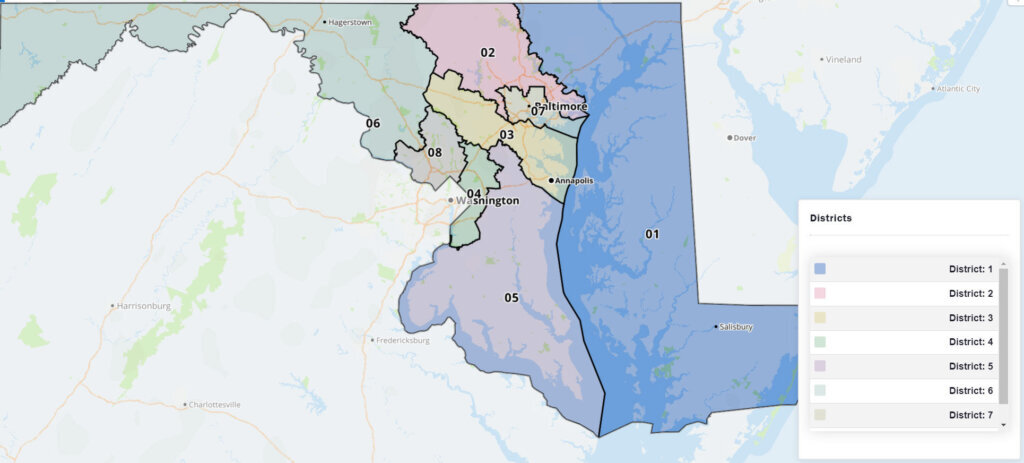Maryland Gov. Larry Hogan signed the new Maryland congressional district map into law.
“This is something that we’ve been focused on for eight years,” Hogan said at a news conference Monday afternoon. “It’s a tremendous victory for democracy and for free and fair elections in Maryland.”
Maryland’s Democratic-controlled state legislature passed the revised congressional map last week.
- Special magistrate: Court of Appeals should deny challenges to Md.’s state legislative map
- More Maryland General Assembly News
- More Maryland News
The new map isn’t “as good as the ones drawn by the citizen commission, and we shouldn’t have wasted so much time, but they are a huge improvement” over the one approved over his veto in December by the General Assembly, which is controlled by Democrats, Hogan said.
That proposal was struck down in Anne Arundel County Circuit Court last month for being too partisan after state Republicans sued, claiming the new map constituted gerrymandering.
Last week, the judge said she wouldn’t issue a ruling on the new map until Hogan had acted on it. Democrats have dropped their appeal of the judge’s decision, and she won’t take any more actions on it.
Hogan pointed out that several Republican-drawn maps have been thrown out nationwide, and that this is the first time that Democratic-drawn maps have been thrown out.
The map will remain in effect for the next decade. Hogan said legislation in the Maryland General Assembly “would fix this process permanently.”
He said the legislature “acted pretty quickly on these maps, in just a matter of days — I’m not sure why they can’t act on that legislation just as fast, and get that done before the session is over with.”
The state legislative maps are also due for a change, and that matter is in Maryland’s highest court, the Court of Appeals, Hogan said.
“They appointed, a master — a retired judge, who’s been doing all the fact finding, and I think he’s supposed to come out with his report tomorrow, and then the Court of Appeals still has to act on that. … But it’s a whole different set of legal issues and a different court.”
Later Monday, a judge issued a report recommending that all four petitions be thrown out in the other challenge of maps in Maryland. The Court of Appeals, as Hogan said, still needs to act on it, but will consider the report when doing so.
Maryland’s highest court already had delayed the state’s primary in a big election year from June 28 to July 19. Voters will decide all 188 seats in the state legislature, open statewide offices such as governor, attorney general and comptroller, a U.S. Senate seat and all eight congressional seats.
Reactions
While Hogan called the new map an improvement over the “really incredibly gerrymandered map that was thrown out by the court,” Democratic officials saw it a little differently.
Maryland Attorney General Brian Frosh, a Democrat, said in a statement, “We are pleased Governor Hogan has agreed to sign the proposed congressional redistricting map approved by the General Assembly. This map, like the one previously passed by the General Assembly, is constitutional and fair. Both sides have agreed to dismiss their appeals, and our state can move forward to the primary election.”
Senate President Bill Ferguson and House Speaker Adrienne Jones said that with the primary about three months away, Marylanders on both sides of the ballot “need to have certainty about what the congressional districts look like.”
The lawmakers called the judge’s interpretation of the Maryland Constitution “novel” and said she had created “brand new legal standards.” But the continued delays were “not in the public’s interest.”
“It is the job of the General Assembly to craft new maps after the census that comply with the law,” the lawmakers said. “We believe we have now done that with the congressional map twice. In the interest of democracy, we have presented the governor with this new congressional map and believe it complies with the trial court judge’s brand new legal standards. We are hopeful the governor’s signature with bring an end to the unnecessary confusion for everyone involved.”
The new map reportedly makes the congressional district in western Maryland more competitive. Incumbent Rep. David Trone, a Democrat, acknowledged that in a statement Monday, but added, “Being disadvantaged by this process is a price I am willing to pay to move Maryland and our country forward. What we now need is a national solution — and for all elected officials across the country to get back to dealing with issues important to those we were elected to represent.”
The new map
The new map makes the districts more compact, but Republican lawmakers contended last week that it’s still riddled with unfair partisan gerrymandering that would likely preserve the 7-1 advantage Democrats have over the GOP in the state’s U.S. House delegation, in a state where registered Democrats outnumber Republicans 2-1.
The map is below; you can also look at it online.

What are the effects?
The redrawn map includes several shifts that could have an impact on the 2022 elections, including in the D.C. area, Maryland Matters reports.
One of the notable changes is to Democratic House Majority Leader Steny H. Hoyer’s 5th District, which would no longer include College Park. That district had long been tailored for Hoyer, looping north and hooking around central Prince George’s County from Southern Maryland to include College Park. Under the latest map, District 5 encompasses a large portion of southern Anne Arundel County and moves north to include Fort Meade rather than turning west toward D.C.
Meanwhile, the 8th District would become even more solidly Democratic. In the 2011 map, the district looped north from Montgomery County to include rural areas of Carroll and northern Frederick counties. It would now be contained entirely within southern Montgomery County, virtually ensuring a Democratic victory in future elections. That district is currently represented by Rep. Jamie B. Raskin, a Democrat.
Another District that would help an incumbent is the newly drawn 1st District, represented by Maryland’s lone congressional Republican, U.S. Rep. Andrew P. Harris, who handily won reelection under the 2011 district map, which included portions of Harford, Baltimore and Carroll counties with the Eastern Shore.
District 1 was set to become much more competitive for Democrats in the December proposal, crossing the Chesapeake Bay to include parts of Anne Arundel County with the Eastern Shore. Under the latest map it would include all of Harford County instead to be a solidly Republican district.
The 4th District no longer would loop north and east from Prince George’s County to include parts of Anne Arundel County, but would be largely contained within Prince George’s County, plus a small area around Burtonsville in Montgomery County. That district will almost certainly lean Democratic and will have an open seat in the upcoming election after incumbent Rep. Anthony G. Brown, a Democrat, embarked on an attorney general bid.
“This map barely gives lip service to Judge Battaglia’s ruling,” said Del. Kathy Szeliga, a Baltimore County Republican who was one of the lawmakers who filed a lawsuit against the initial map, adding that the redrawn version is “still an extreme gerrymander.”
Del. Eric Luedtke, the House majority leader, said the new map has significantly more compact districts and reduces the number of county crossings in districts.
The map approved in December by a panel of lawmakers added Democrats to the lone Republican-held district, making a more competitive race for Republican Rep. Andy Harris. It also created the potential for Democrats to go 8-0 in Maryland.
The new map removes a portion that stretched Harris’ Eastern Shore district across the Chesapeake Bay into an area with more Democrats and restores GOP strength in the 1st Congressional District.
Maryland Matters and The Associated Press contributed to this report.








